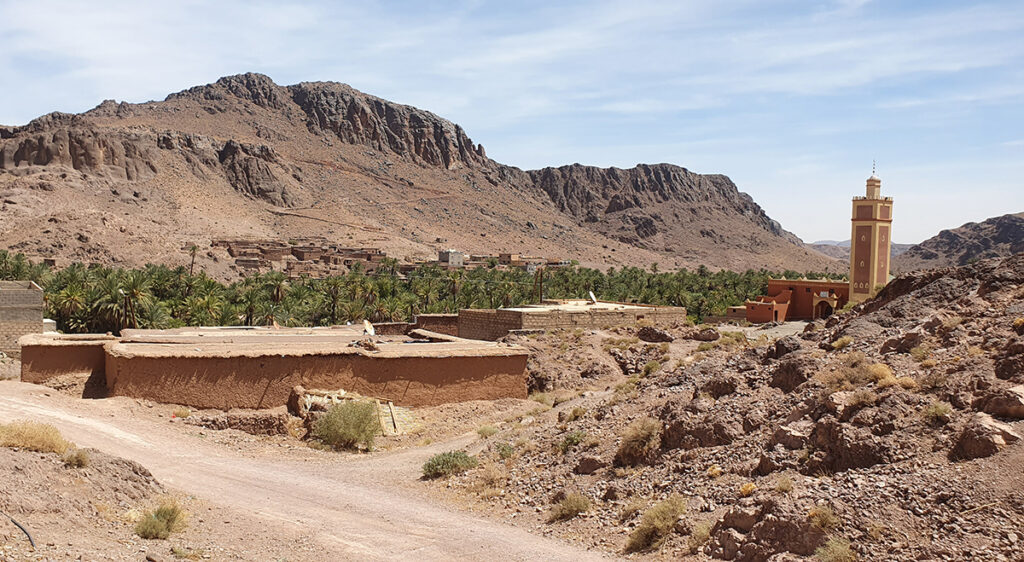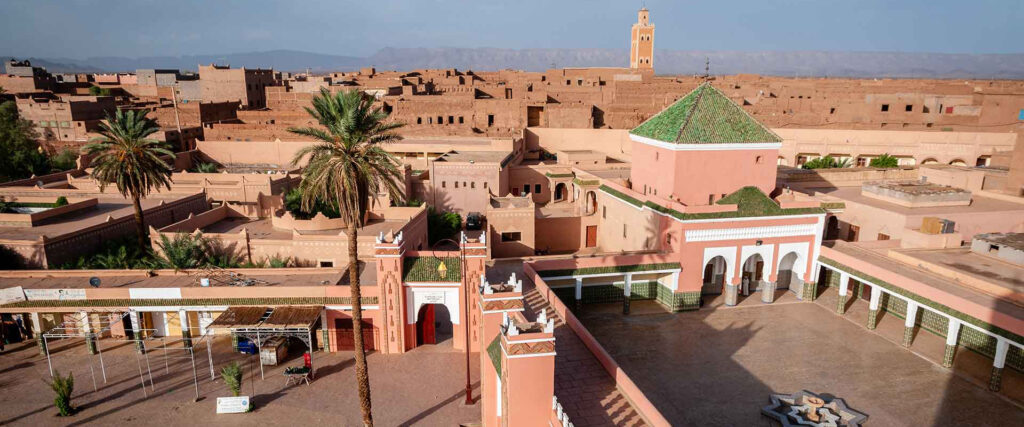Today, the village of Fint is no longer the oasis it once was; time, climatic vagaries, and population movements have continuously transformed it. Its ancient ruins, fields, and valley appear silent and asleep when first glimpsed, yet they hold a long history inscribed within collective memory and recounted through the diverse voices of its women and men. It’s a collective history passed down through oral tradition where the real, the legendary, and the mythical merge. Tales are woven together, intermingled, forgotten, and reconstructed to narrate to the world the story of the Fint oasis.
Lhaj Elhassane Aghlane, born in 1933, is one of the few elders from Fint still alive today. He testifies about the tribal life of yesteryears. His narrative resurrects the lived past, bringing it to life through words laden with strong emotional resonance, infused with nostalgia for those times when Fint …
« lived in tune with the seasonal toil of men who did not overlook the smallest plot of land to ensure their livelihood. »
Lhaj Elhassane Aghlane

Fint, the origins of an Amazigh tribe
The majority of families in Fint reportedly arrived successively from the Draa region and other areas of southeastern Morocco, notably from the Tata region. They fled droughts, epidemics, famine, and tribal conflicts. An Amazigh community settled in this remote place, which at that time provided rudimentary yet sufficient living conditions due to the intermittent waters of the Fint wadi.
« We originate from Alougoum in the Tata region. The other families in Fint came from various regions. Only one family would be considered indigenous: the Harbouli family, known as Ait Baha Ali. »
Lhaj Elhassane Aghlane
The early inhabitants settled on the north bank of the Fint wadi. Modest earthen homes were built a few meters above the valley, on the slope of the Tassegdelte rock, sheltered from the devastating floods that inundated the oasis during the heavy rainy seasons.
For a long time, only inhabitants with darker skin populated the Fint Oasis. However, oral history mentions the presence of a wealthy Berber family with fair skin that had left Fint over a century ago. This family allegedly had ties to the saint Sidi M’hend Ou Moussa, managing his trade until their permanent departure from Fint due to a wave of mosquito invasion.
During the French Protectorate and the period of caidalism in Morocco, two prominent village leaders wielded their authority over Fint: Amghar Hammou N’Ali Oubaha from the village of Taherblit and M’hend Ou R’hou from the village of Timoula. Both were assistants to the Glaoua caids who held sway over the High Atlas and the southeastern region of Morocco.
At that time, Fint was not exempt from the dictates of the Caïd El Glaoui, who had his official residence in the kasbah of Telouet. The oasis inhabitants were at the mercy of confiscations of property and any other valuable belongings.
« The Iglioua (Glaoua in Amazigh) stripped us of our possessions: fields, livestock, cloaks, robes, silver daggers, camels… They seized everything within their reach. »
Lhaj Elhassane Aghlane
The Glaoua caliphates, particularly Si Mohamed established in the kasbah of Taourirte and Ou-Tzggart in that of Tifoultoute, wielded their absolute power over the tribes. Mandatory labor was imposed on all boys over twelve years old. It involved assisting in plowing, harvesting, or construction works in the service of the Glaoua masters.

« A town crier appointed by the Glaoua caliphate in Fint publicly announced the call for participation in forced labor. Every man in our tribe was required to work for a duration of four days. Anyone failing in this obligation had to pay a tax or risk having their property confiscated. During visits by Pasha Thami Elglaoui to Ouarzazate, we went to welcome him, men and women dressed according to the customs of official celebrations befitting the pasha’s rank. This meant white djellabas, turbans, and babouches for men; light white fabric draped over the shoulder with filigree-decorated fibulas mixed with other types of ornaments, or the bright red and yellow-colored ‘leqtib’ scarf for women. We subsisted on a few dates as food. All the tribes of Ouarzazate gathered in the kasbah of Taourirte where the Pasha stayed. Ahouach singing and dancing continued day and night in honor of the Pasha throughout his visit.»
Lhaj Elhassane Aghlane

A rustic way of life in an age-old oasis.
For centuries, the inhabitants of Fint cultivated plots of land on the banks of the river that irrigated orchards where vineyards, fig trees, date palms – the quintessential providential tree – flourished. Dates were a staple food that ensured the subsistence of families, especially during times of scarcity
Traces confirm a centuries-old presence of this population in the oasis.
« My father passed away at the age of 110. He used to tell me that since his childhood, the large cemetery and a mosque where more than 400 men pray had already existed. »
Lhaj Elhassane Aghlane
The predominantly dark-skinned population, although exclusively living in Fint, did not own much of the agricultural land cultivated in its territory. The neighboring white Berber tribes like Taguenezalt and Ighelss were the owners. The inhabitants of Fint worked there only as Khamass or sharecroppers, being paid only one-fifth of the harvest.
Times were often tough due to structural droughts and epidemics. The inhabitants sold their lands to survive.
« We sold our lands in exchange for a bowl of barley. At that time, there was no flour. We would go to Ouarzazate to beg for a bit of flour made from barley. We prepared a soup with dried turnips cooked in clay pots. As for clothes, there were hardly any. We dressed in patched rags made from worn American fabric. At night, we covered ourselves with palm leaf mats. Despite these conditions of poverty, we were resilient; we worked our lands, tended to our meager herds, and gathered firewood … »
Lhaj Elhassane Aghlane
A lire : The oasis bears the seeds of tomorrow’s Morocco, and of the world

A few Jewish families, such as Boubssou, Boutkjtatt, Ben Ouenza, lived within the tribe of Fint. These families held a relatively privileged social status. They engaged in usury and trade.
« Jewish families lived in Fint. Jews were numerous in other villages of Ouarzazate, especially Tazroute, Taourirte, Aouerz, Telmasla, Tamassinte, Tikirte… They were wealthier than us. The Glaoua Caids treated them with leniency.»
Lhaj Elhassane Aghlane
After challenging times, periods of rain followed, watering the fields, nourishing the canals, valleys, and springs. These waters brought joy to the hearts of the inhabitants of Fint, witnessing a rebirth of their oasis; greenery covered the pastures, and all the gardens thrived. The small oasis, whose economy relied on subsistence agriculture and pastoralism, suddenly experienced times of abundance.
« We raised sheep, oxen, and cows. Flowers grew everywhere, and wild beehives were abundant in the vicinity. Deer ventured close to the villages. Wolves, foxes, and hares were plentiful…»
Lhaj Elhassane Aghlane
In gratitude to God for His generosity during times of abundance and in adherence to their ancestral customs, the inhabitants of Fint organized an annual customary celebration: the Moussem of Sidi M’hend Ou Moussa, descendants of the famous saint from the southern Moroccan region, Sidi Ahmed Ou Moussa, whose Zaouia is located in a village bearing his name in the Tazeroualt commune, Tiznit Province.
This ceremony was observed every first Friday of the year at the mausoleum of this local saint.
The Moqadem of the mausoleum, a local representative of authority or a kind of deputy, managed the saint’s possessions, including rented palm trees to third parties and the sale of livestock. These resources formed a fund dedicated to the mausoleum of Sidi M’hend Ou Mouassa.
On the eve of the Moussem, the day of the ceremony was announced in Ouarzazate to inform other tribes. It was an occasion to celebrate Fint’s connection to its traditions and the renewal of its ties with other tribes.
« The Moqadem of the Zaouia records all the resources of the mausoleum in a ledger. We sent emissaries to the weekly market in Ouarzazate to announce the day of the Moussem. Each family in Fint contributes to the organization of this ceremony. A cow is purchased to be sacrificed as an offering to the saint. A communal meal is prepared; dishes of couscous, known as ‘maârouf,’ are generously offered to all our guests. Tribes come from everywhere, bringing goats and sheep to sacrifice at the saint’s tomb. They sing and dance the Ahwach dance throughout the night. »
Lhaj Elhassane Aghlane
These times are over. In the oasis of Fint, the guardians of tradition peacefully live out the twilight of their lives. The history of Fint is not merely a memory. It has become an integral part of the heritage, wealth, and identity of Southeastern Morocco.






